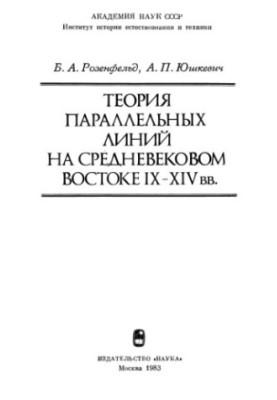Parallel Line Theory in the Medieval East
 Instant download
Instant download
after payment (24/7)
 Wide range of formats
Wide range of formats
(for all gadgets)
 Full book
Full book
(including for Apple and Android)
The Theory of Parallel Lines in the Medieval East by Rosenfeld B. A. and Yushkevich A. P. It is a fascinating and in-depth study that immerses readers in the world of mathematics and philosophy that developed in the East in the Middle Ages. This work is not only for lovers of mathematics, but also for everyone who is interested in the history of science, culture and the development of human thought. The authors focus on one of the key topics of geometry the theory of parallel lines. While in the Western tradition this topic has been explored within the framework of Euclidean geometry, Eastern scientists have offered their unique views and approaches. Rosenfeld and Yushkevich take the liberty to investigate how the various cultures and philosophical schools of the East perceived and developed ideas related to parallel lines, and how these ideas influenced the further development of mathematics. The book is not limited to mathematical concepts . It covers a wide range of topics, from philosophical reflections on the nature of space and time to the cultural contexts in which these ideas developed. The authors skillfully combine scientific facts with historical anecdotes, which makes reading not only informative, but also fascinating. The reader will be able to learn about the great thinkers of the East, such as Al-Khwarizmi and Ibn Sina, and their contribution to the development of geometry. "The theory of parallel lines in the medieval East" will be of interest not only to students and teachers of mathematics, but also to everyone who is fond of the history of science, culture and philosophy. This work is suitable for both young audiences and more mature readers who want to broaden their horizons and deepen their knowledge of the mathematical concepts that shaped our perception of the world. The topics raised in the book are still relevant today. The authors explore how scientific ideas can intersect with cultural and philosophical traditions, and how this interaction affects our understanding of the world around us. In modern society, where science and culture are often perceived as separate spheres, the book recalls the importance of their interconnection. Rosenfeld and Yushkevich's style is distinguished by clarity and accessibility. They are able to explain complex concepts in simple and understandable language, which makes their work accessible to a wide audience. This is not just a scientific study, but a fascinating journey through the pages of history, which makes you think about how far we have progressed in our knowledge and how much remains to be discovered. If you are interested in such works as "History of mathematics" K. K. Meletinsky or "Mathematics and Culture" D. D. Castells, the "Theory of Parallel Lines in the Medieval East" will be a real find for you This book not only enriches knowledge, but also inspires further research and reflection on the place of mathematics in our lives. In conclusion, "The Theory of Parallel Lines in the Medieval East" is not just a book about mathematics, it is an in-depth study that opens up new horizons for the reader and makes him think about how knowledge is formed and transmitted through the centuries. It deserves the attention of anyone who wants to understand how science and culture intertwine in our world.
LF/10363425/R
Data sheet
- Name of the Author
- Розенфельд Б.А.
Юшкевич А.П. - Language
- Russian
- Release date
- 1983



























